Influence of Three Gorges Dam on Downstream Low Flow
Abstract
1. Introduction
2. Data and Methodology
2.1. Study Area and Data
2.2. Methodology
3. Results
3.1. The Impact of the Three Gorges Dam (TGD) on the Main Yangtze Rive
3.2. The Impacts of TGD on Downstream Low Flow in the Yangtze River
3.3. The Impacts of the TGD on Minimum Streamflow of the Main Yangtze River
4. Discussion
5. Conclusions
- (1)
- The operation of the TGD has significantly increased the downstream low flow. The TGD has increased the low streamflow of the extreme drought years and slightly decreased the high value streamflow of the extreme wet years. Generally, the TGD has greatly changed the monthly and interannual distribution of streamflow in the lower Yangtze River.
- (2)
- The start date of the dry season in the upper Yangtze River basin was delayed for 21 days, however, the start dates of the dry season at Yichang, Hankou and Datong stations were advanced for 14, 10 and 9 days, respectively. The advancing of the start date of dry season could aggravate the impacts of the drought in October in the lower Yangtze River.
- (3)
- The minimum streamflow in the lower Yangtze River has increased obviously after the TGD operation. The minimum streamflow has increased by 42.91%, 13.76% and 6.06% at Yichang, Hankou and Datong stations, respectively. Moreover, the minimum streamflow in 100 years has increase obviously at Yichang station. Therefore, large dams in the Yangtze River has had a great impacts on the downstream low flow and similar things happen all over the world. More work should be done to study the complexity and risk affected by large dams on downstream low flow all over the world.
Author Contributions
Funding
Acknowledgments
Conflicts of Interest
References
- Longobardi, A.; Villani, P. Baseflow index regionalization analysis in a mediterranean area and data scarcity context: Role of the catchment permeability index. J. Hydrol. 2008, 355, 63–75. [Google Scholar] [CrossRef]
- Zhou, Z.; Ouyang, Y.; Qiu, Z.; Zhou, G.; Lin, M.; Li, Y. Evidence of climate change impact on stream low flow from the tropical mountain rainforest watershed in Hainan Island, China. J. Water Clim. Chang. 2017, 8, 293–302. [Google Scholar] [CrossRef]
- Smakhtin, V.U. Low flow hydrology: A review. J. Hydrol. 2001, 240, 147–186. [Google Scholar] [CrossRef]
- Sun, Y.Y.; Sun, P.; Yao, R.; Zhang, Q.; Shi, P.J.; Wang, Y.Z. Characteristics of low streamflow: Possible causes and implications in Huaihe River basin. J.Beijing Normal Univ. (Nat. Sci.) 2018, 54, 543–552. (In Chinese) [Google Scholar]
- Wang, P. Analysis on the period characteristic of low flow in pearl river basin and effect factors. J. Hydraul. Eng. 2007, 1, 379–382. (In Chinese) [Google Scholar]
- Lu, L.J. Reason analysis and reflection of lower water level in low flow period on Poyang Lake and the Jiujiang reach of Changjiang River. Jiangxi Hydral. Sci. Technol. 2014, 40, 126–129. (In Chinese) [Google Scholar]
- Zhang, D. Navigational Risk Assessment in the Dry Season of Yangtze River. Ph.D. Thesis, Wuhan University of Technology, Wuhan, China, 2011. (In Chinese). [Google Scholar]
- Palmer, T.A.; Montagna, P.A. Impacts of droughts and low flows on estuarine water quality and benthic fauna. Hydrobiologia 2015, 753, 111–129. [Google Scholar] [CrossRef]
- Mosley, L.M.; Zammit, B.; Leyden, E.; Heneker, T.M.; Hipsey, M.R.; Skinner, D.; Aldridge, K.T. The Impact of Extreme Low Flows on the Water Quality of the Lower Murray River and Lakes (South Australia). Water Resour. Manag. 2012, 26, 3923–3946. [Google Scholar] [CrossRef]
- Dewson, Z.S.; Alexander, B.W.J.; Death, R.G. A review of the consequences of decreased flow for instream habitat and macroinvertebrates. J. N. Am. Benthol. Soc. 2007, 26, 401–415. [Google Scholar] [CrossRef]
- McKay, S.F.; King, A.J. Potential ecological effects of water extraction in small unregulated streams. River Res. Appl. 2006, 22, 1023–1037. [Google Scholar] [CrossRef]
- Stanley, E.H.; Fisher, S.G.; Grimm, N.B. Ecosystem Expansion and Contraction in Streams. Bioscience 1997, 47, 427–435. [Google Scholar] [CrossRef]
- Caruso, B.S. Temporal and spatial patterns of extreme low flows and effects on stream ecosystems in Otago, New Zealand. J. Hydrol. 2002, 257, 115–133. [Google Scholar] [CrossRef]
- Donnelly, T.H.; Grace, M.R.; Hart, B.T. Algal blooms in the Darling-Barwon River, Australia. Water Air Soil Poll. 1997, 99, 487–496. [Google Scholar] [CrossRef]
- van Vliet, M.; Ludwig, F.; Zwolsman, J.; Weedon, G.; Kabat, P. Global river temperatures and sensitivity to atmospheric warming and changes in river flow. Water Resour. Res. 2011, 47, W2544. [Google Scholar] [CrossRef]
- van Vliet, M.T.H.; Zwolsman, J.J.G. Impact of summer droughts on the water quality of the Meuse river. J. Hydrol. 2008, 353, 1–17. [Google Scholar] [CrossRef]
- Lake, P.S. Disturbance, patchiness, and diversity in streams. J. N. Am. Benthol. Soc. 2000, 19, 573–592. [Google Scholar] [CrossRef]
- Poff, N.L.; Voelz, N.J.; Ward, J.V.; Lee, R.E. Algal colonization under four experimentally-controlled current regimes in a high mountain stream. J. N. Am. Benthol. Soc. 1990, 9, 303–318. [Google Scholar] [CrossRef]
- Walters, A.W.; Post, D.M. How low can you go? Impacts of a low-flow disturbance on aquatic insect communities. Ecol. Appl. 2011, 21, 163–174. [Google Scholar] [CrossRef]
- Bond, N.R.; Lake, P.S.; Arthington, A.H. The impacts of drought on freshwater ecosystems: An Australian perspective. Hydrobiologia 2008, 600, 3–16. [Google Scholar] [CrossRef]
- Caruso, B.S. Regional river flow, water quality, aquatic ecological impacts and recovery from drought. Hydrol. Sci. J. 2001, 46, 677–699. [Google Scholar] [CrossRef]
- Tallaksen, L.M.; van Lanen, H.A.J. Hydrological Drought-Processes and Estimation Methods for Streamflow and Groundwater; Elsevier: Amsterdam, The Netherlands, 2004. [Google Scholar]
- Bowles, D.S.; Riley, J.P. Low flow modeling in small steep watersheds. J. Hydraul. Div. 1976, 102, 1225–1239. [Google Scholar]
- Gurnell, A.M. How many reservoirs? An analysis of flow recession from a glacier basin. J. Glaciol. 1993, 39, 409–414. [Google Scholar] [CrossRef]
- Hopkinson, C.; Young, G.J. The effect of glacier wastage on the flow of the Bow River at Banff, Alberta, 1951–1993. Hydrol. Processes 1998, 12, 1745–1762. [Google Scholar] [CrossRef]
- Fountain, A.G.; Tangborn, W.V. The Effect of Glaciers on Streamflow Variations. Water Resour. Res. 1985, 21, 579–586. [Google Scholar] [CrossRef]
- Hamlet, A.F.; Mote, P.W.; Clark, M.P.; Lettenmaier, D.P. Effects of Temperature and Precipitation Variability on Snowpack Trends in the Western United States. J. Clim. 2005, 18, 4545–4561. [Google Scholar] [CrossRef]
- McCabe, G.J.; Clark, M.P. Trends and Variability in Snowmelt Runoff in the Western United States. J. Hydrometeorol. 2005, 6, 476–482. [Google Scholar] [CrossRef]
- Stewart, I.T.; Cayan, D.R.; Dettinger, M.D. Changes in snowmelt runoff timing in western North America under a ’Business as Usual’ climate change scenario. Clim. Chang. 2004, 62, 217–232. [Google Scholar] [CrossRef]
- Stewart, I.T.; Cayan, D.R.; Dettinger, M.D. Changes toward Earlier Streamflow Timing across Western North America. J. Clim. 2005, 18, 1136–1155. [Google Scholar] [CrossRef]
- Stewart, I.T. Changes in snowpack and snowmelt runoff for key mountain regions. Hydrol. Process 2009, 23, 78–94. [Google Scholar] [CrossRef]
- White, E.L. Sustained flowin small Appalachian watersheds. Hydrol. Process 1977, 32, 71–86. [Google Scholar] [CrossRef]
- Marquès, M.; Bangash, R.F.; Kumar, V.; Sharp, R.; Schuhmacher, M. The impact of climate change on water provision under a low flow regime: A case study of the ecosystems services in the Francoli river basin. J. Hazard. Mater. 2013, 263, 224–232. [Google Scholar] [CrossRef] [PubMed]
- Owen, M. Groundwater Abstraction and River Flows. Water Environ. J. 2010, 5, 697–702. [Google Scholar] [CrossRef]
- Hetherington, E.D. Effects offorest harvesting on the hydrologic regime of carnation creek experimental watershed: A preliminary assessment. In Associate Committee on Hydrology; Canadian Hydrology Symposium: Fredericton, NB, Canada, 1982. [Google Scholar]
- Harr, R.D.; Levno, A.; Mersereau, R. Streamflow Changes After Logging 130-Year-Old Douglas Fir in Two Small Watersheds. Water Resour. Res 1982, 18, 637–644. [Google Scholar] [CrossRef]
- Hicks, B.J.; Beschta, R.L.; Harr, R.D. Long-term changes in streamflow following logging in western Oregon and associated fisheries implication. Water Resour. Bull. 1991, 27, 217–226. [Google Scholar] [CrossRef]
- Keppeler, E.T.; Ziemer, R.R. Logging effects on streamflow: Water yield and summer low flows at Caspar Creek in northwestern California. Water Resour. Res. 1990, 26, 1669–1679. [Google Scholar] [CrossRef]
- Smith, R.E. Effect of clearfelling pines on water yield in a small Eastern Transvaal catchment, South Africa. Water S. A. 1991, 17, 217–224. [Google Scholar]
- Bickerton, M.; Petts, G.; Armitage, P.; Castella, E. Assessing the ecological effects of groundwater abstraction on chalk streams: Three examples from Eastern England. Regul. Rivers Res. Mgmt. 1993, 8, 121–134. [Google Scholar] [CrossRef]
- Vörösmarty, C.J.; Green, P.; Salisbury, J.; Lammers, R.B. Global Water Resources: Vulnerability from Climate Change and Population Growth. Science 2000, 289, 284–288. [Google Scholar] [CrossRef]
- Williams, G.P.; Gordon, W.M. Downstream Effects of Dams on Alluvial Rivers; Professional Paper; Geological Survey: Washington, DC, USA, 1984; Volume 1286, p. 83. [Google Scholar]
- Friedman, J.M.; Osterkamp, W.R.; Scott, M.L.; Auble, G.T. Downstream effects of dams on channel geometry and bottomland vegetation: Regional patterns in the great plains. Wetlands 1998, 18, 619–633. [Google Scholar] [CrossRef]
- Nilsson, C.; Reidy, C.A.; Dynesius, M.; Revenga, C. Fragmentation and Flow Regulation of the World’s Large River Systems. Science 2005, 308, 405–408. [Google Scholar] [CrossRef]
- Botter, G.; Basso, S.; Porporato, A.; Rodriguez-Iturbe, I.; Rinaldo, A. Natural streamflow regime alterations: Damming of the Piave river basin (Italy). Water Resour. Res. 2010, 46, 1–14. [Google Scholar] [CrossRef]
- Mix, K.; Groeger, A.W.; Lopes, V.L. Impacts of dam construction on streamflows during drought periods in the Upper Colorado River Basin, Texas. Lakes Reserv. Res. Manag. 2016, 21, 329–337. [Google Scholar] [CrossRef]
- FitzHugh, T.W.; Vogel, R.M. The impact of dams on flood flows in the United States. River Res. Appl. 2011, 27, 1192–1215. [Google Scholar] [CrossRef]
- Burke, M.; Jorde, K.; Buffington, J.M. Application of a hierarchical framework for assessing environmental impacts of dam operation: Changes in streamflow, bed mobility and recruitment of riparian trees in a western North American river. J. Environ. Manag. 2009, 90, S224–S236. [Google Scholar] [CrossRef] [PubMed]
- Cowell, C.M.; Stoudt, R.T. Dam-induced Modifications to Upper Allegheny River Streamflow Patterns and Their Biodiversity Implications. J. Am. Water Resour. A. S. 2002, 38, 187–196. [Google Scholar] [CrossRef]
- Neal, B.P.; Shephard, P.; Austin, K.A.; Nathan, R.J.; Merz, S.K. The Effect of Catchment Farm Dams on Streamflows-Victorian Case Studies. In Proceedings of the Hydro 2000: Interactive Hydrology, Barton, Australia, 5 October 2000. [Google Scholar]
- Bonacci, O.; Oskoruš, D. The changes in the lower Drava River water level, discharge and suspended sediment regime. Environ. Earth Sci. 2010, 59, 1661–1670. [Google Scholar] [CrossRef]
- Qiu, J. China admits problems with Three Gorges Dam. Nature 2011. [CrossRef]
- Dai, Z.J.; Du, J.Z.; Li, J.F.; Li, W.H.; Chen, J.Y. Runoff characteristics of the Changjiang River during 2006: Effect of extreme drought and the impounding of the Three Gorges Dam. Geophys. Res. Lett. 2008, 35, L7401–L7406. [Google Scholar] [CrossRef]
- Guo, H.; Hu, Q.; Zhang, Q.; Feng, S. Effects of the Three Gorges Dam on Yangtze River flow and river interaction with Poyang Lake, China: 2003–2008. J. Hydrol. 2012, 416–417, 19–27. [Google Scholar] [CrossRef]
- Lai, X.J.; Jiang, J.H.; Yang, G.S.; Lu, X.X. Should the Three Gorges Dam be blamed for the extremely low water levels in the middle-lower Yangtze River? Hydrol. Process 2014, 28, 150–160. [Google Scholar] [CrossRef]
- Guo, H.; Hu, Q.; Zhang, Q. Changes in hydrological interactions of the Yangtze River and the Poyang Lake in China during 1957–2008. J. Geogr. Sci. 2011, 66, 609–618. [Google Scholar]
- Yang, S.L.; Zhang, J.; Xu, X.J. Influence of the Three Gorges Dam on downstream delivery of sediment and its environmental implications, Yangtze River. Geophys. Res. Lett. 2007, 34, L10401. [Google Scholar] [CrossRef]
- Chen, X.Q.; Zong, Y.Q.; Zhang, E.F.; Xu, J.G.; Li, S.J. Human impacts on the Changjiang (Yangtze) River basin, China, with special reference to the impacts on the dry season water discharges into the sea. Geomorphology 2001, 41, 111–123. [Google Scholar] [CrossRef]
- Zhang, Q.; Li, L.; Wang, Y.G.; Werner, A.D.; Xin, P.; Jiang, T.; Barry, D.A. Has the Three-Gorges Dam made the Poyang Lake wetlands wetter and drier? Geophys. Res. Lett. 2012, 39, L20401–L20402. [Google Scholar] [CrossRef]
- Deng, J.Y.; Fan, S.Y.; Pang, C.N.; Liu, C.C. Adjustment of Regulation and Storage Capacity of Lakes in the Middle Yangtze River Basin During Impoundment of Three Gorges Reservoir. J. Yangtze River Sci. Res. Inst. 2018, 35, 147–152. (In Chinese) [Google Scholar]
- Zhang, Q.; Ye, X.H.; Werner, A.D.; Li, Y.L.; Yao, J.; Li, X.H.; Xu, C.Y. An investigation of enhanced recessions in Poyang Lake: Comparison of Yangtze River and local catchment impacts. J. Hydrol. 2014, 517, 425–434. [Google Scholar] [CrossRef]
- Cao, L.J.; Zhang, Y.; Shi, Y. Climate change effect on hydrological processes over the Yangtze River basin. Quatern. Int. 2011, 244, 202–210. [Google Scholar] [CrossRef]
- Gemmer, M.; Jiang, T.; Su, B.; Kundzewicz, Z.W. Seasonal precipitation changes in the wet season and their influence on flood/drought hazards in the Yangtze River Basin, China. Quatern. Int. 2008, 186, 12–21. [Google Scholar] [CrossRef]
- Yu, F.L.; Chen, Z.Y.; Ren, X.Y.; Yang, G.F. Analysis of historical floods on the Yangtze River, China: Characteristics and explanations. Geomorphology 2009, 113, 210–216. [Google Scholar] [CrossRef]
- Gao, B.; Yang, D.W.; Zhao, T.T.G.; Yang, H.B. Changes in the eco-flow metrics of the Upper Yangtze River from 1961 to 2008. J. Hydrol. 2012, 448–449, 30–38. [Google Scholar] [CrossRef]
- Zhang, Q.; Liu, C.L.; Xu, C.Y.; Xu, Y.P.; Jiang, T. Observed trends of annual maximum water level and streamflow during past 130 years in the Yangtze River basin, China. J. Hydrol. 2006, 324, 255–265. [Google Scholar] [CrossRef]
- Yin, H.F.; Liu, G.R.; Pi, J.G.; Chen, G.J.; Li, C.A. On the river–lake relationship of the middle Yangtze reaches. Geomorphology 2007, 85, 197–207. [Google Scholar] [CrossRef]
- Zhang, Z.X.; Chen, X.; Xu, C.Y.; Hong, Y.; Hardy, J.; Sun, Z.H. Examining the influence of river–lake interaction on the drought and water resources in the Poyang Lake basin. J. Hydrol. 2015, 522, 510–521. [Google Scholar] [CrossRef]
- Wang, D.; Li, Y.T.; Deng, J.Y.; Yang, Y.P. Preliminary analysis of changes in hydraulic elements of Dongting lake in storage period of Three Gorges reservoir. J. Hydroelectr. Eng. 2014, 33, 26–32. (In Chinese) [Google Scholar]
- Liu, W.B.; Yang, T.; Du, M.Y.; Sun, F.B.; Liu, C.M. Impact of the Three Gorges Dam on the Hydrology Mechanism of Typical Hydrologic Stations in the Middle and Lower Reaches of the Yangtze River. Ecol. Environ. Monit. TG 2018, 3, 8–15. (In Chinese) [Google Scholar]
- Montgomery, D.R.; Greenberg, H.M.; Smith, D.T. Streamflow response to the Nisqually earthquake. Earth Planet. Sci. Lett. 2003, 209, 19–28. [Google Scholar] [CrossRef]
- Wang, J.; Yu, Y.; Ou, G.Q.; Pan, H.L.; Qiao, C. Flash Flood Risk Zoning of Areas Hit by Wenchuan Earthquake in the Upper Reach of Minjiang River. J. Yangtze River Sci. Res. Inst. 2017, 34, 54–60. (In Chinese) [Google Scholar]
- Bernard, B.; Vincent, K.; Frank, M.; Anthony, E. Comparison of extreme weather events and streamflow from drought indices and a hydrological model in River Malaba, Eastern Uganda. Int. J. Environ. Stud. 2013, 70, 940–951. [Google Scholar] [CrossRef]
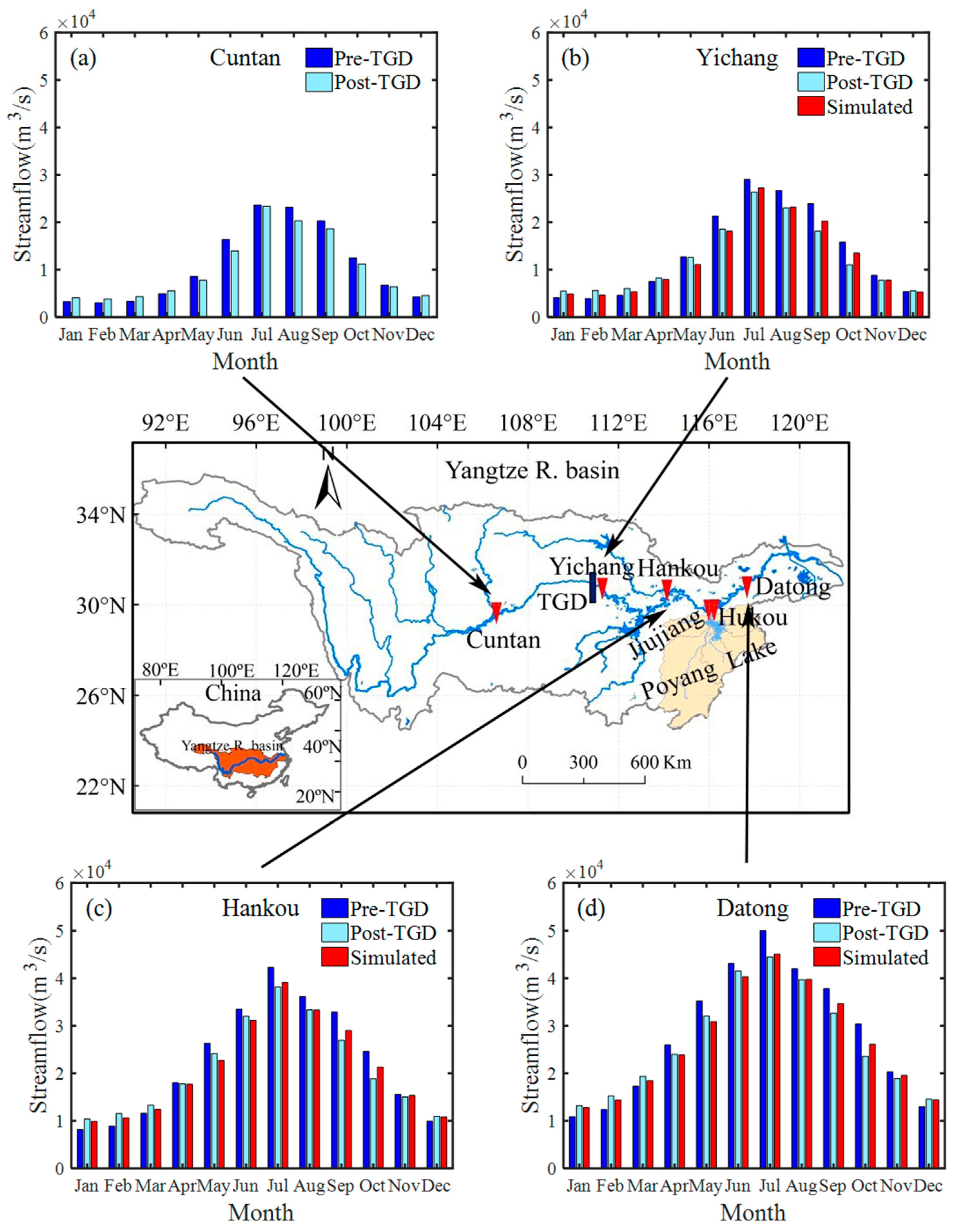
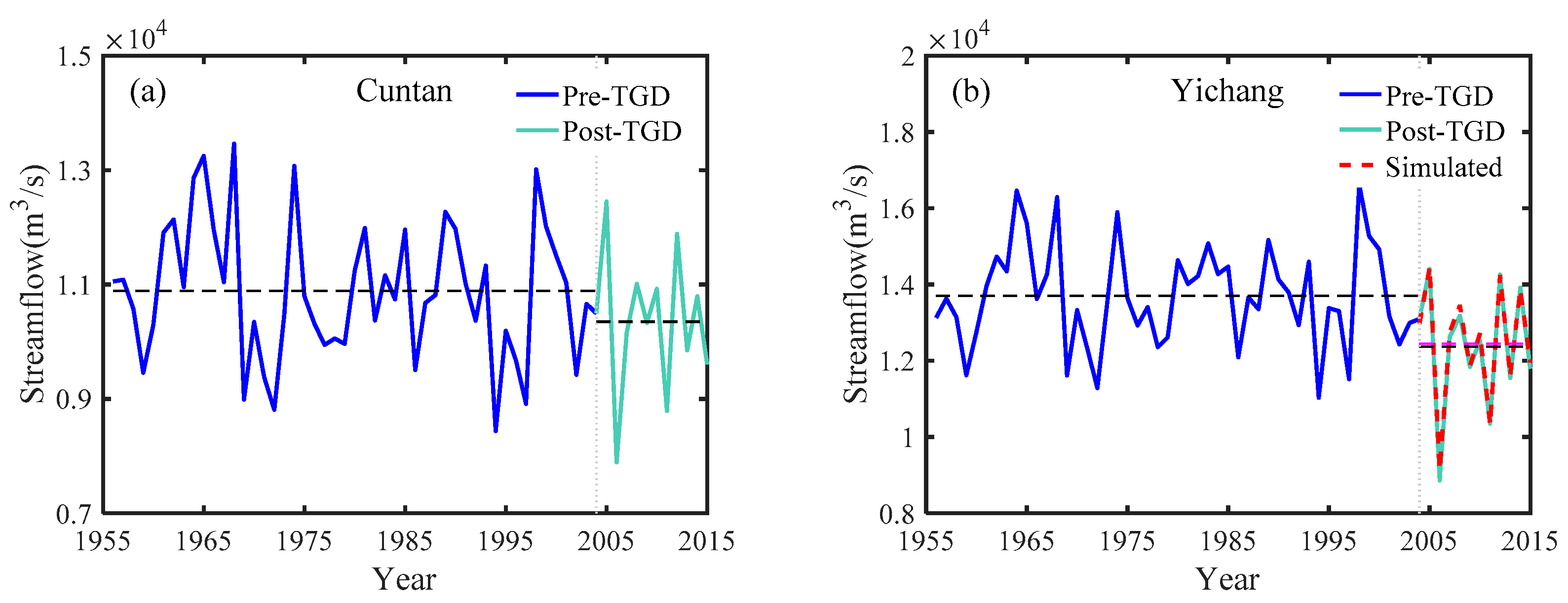
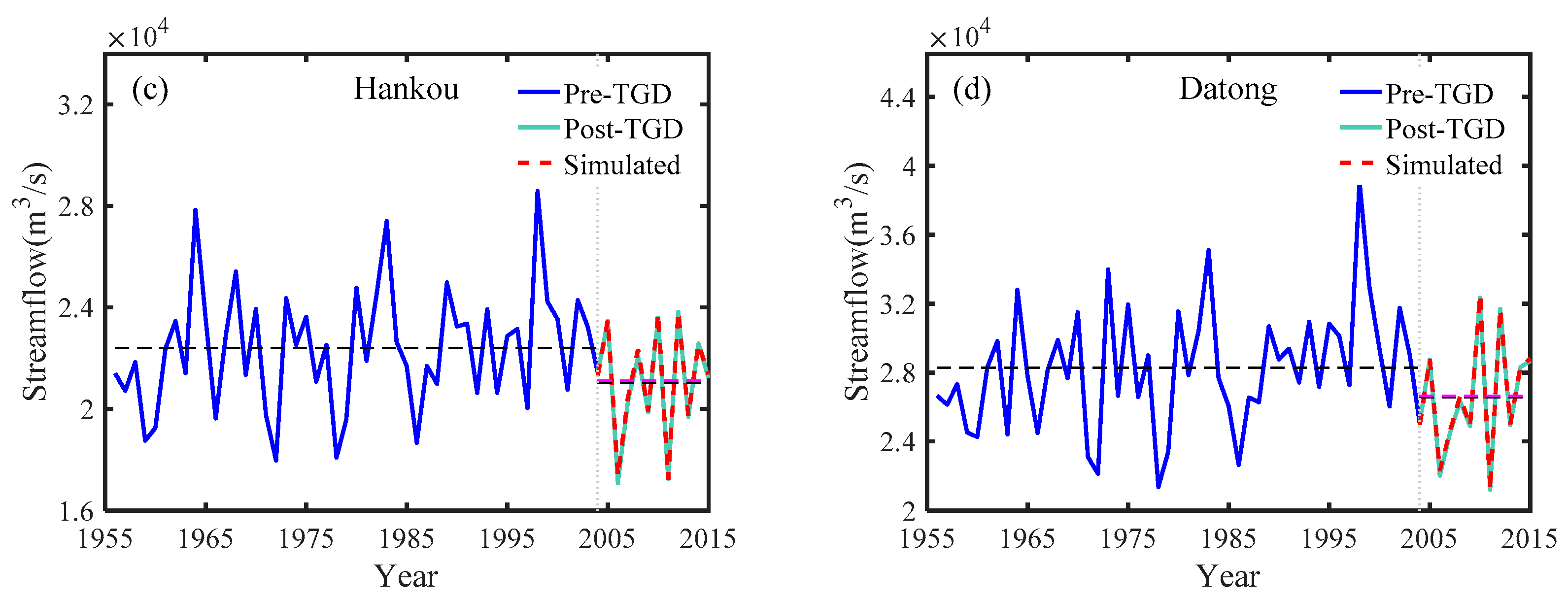
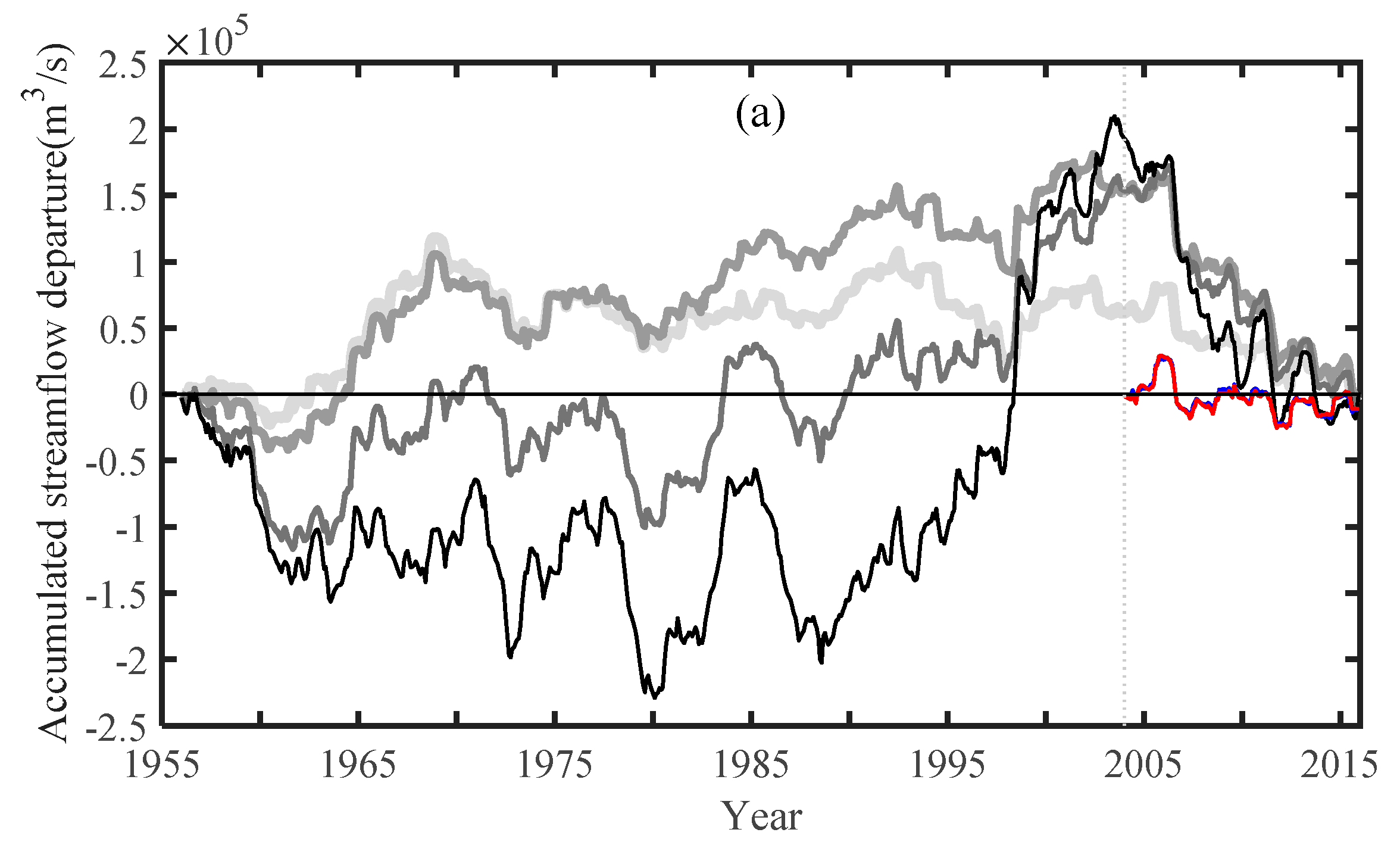
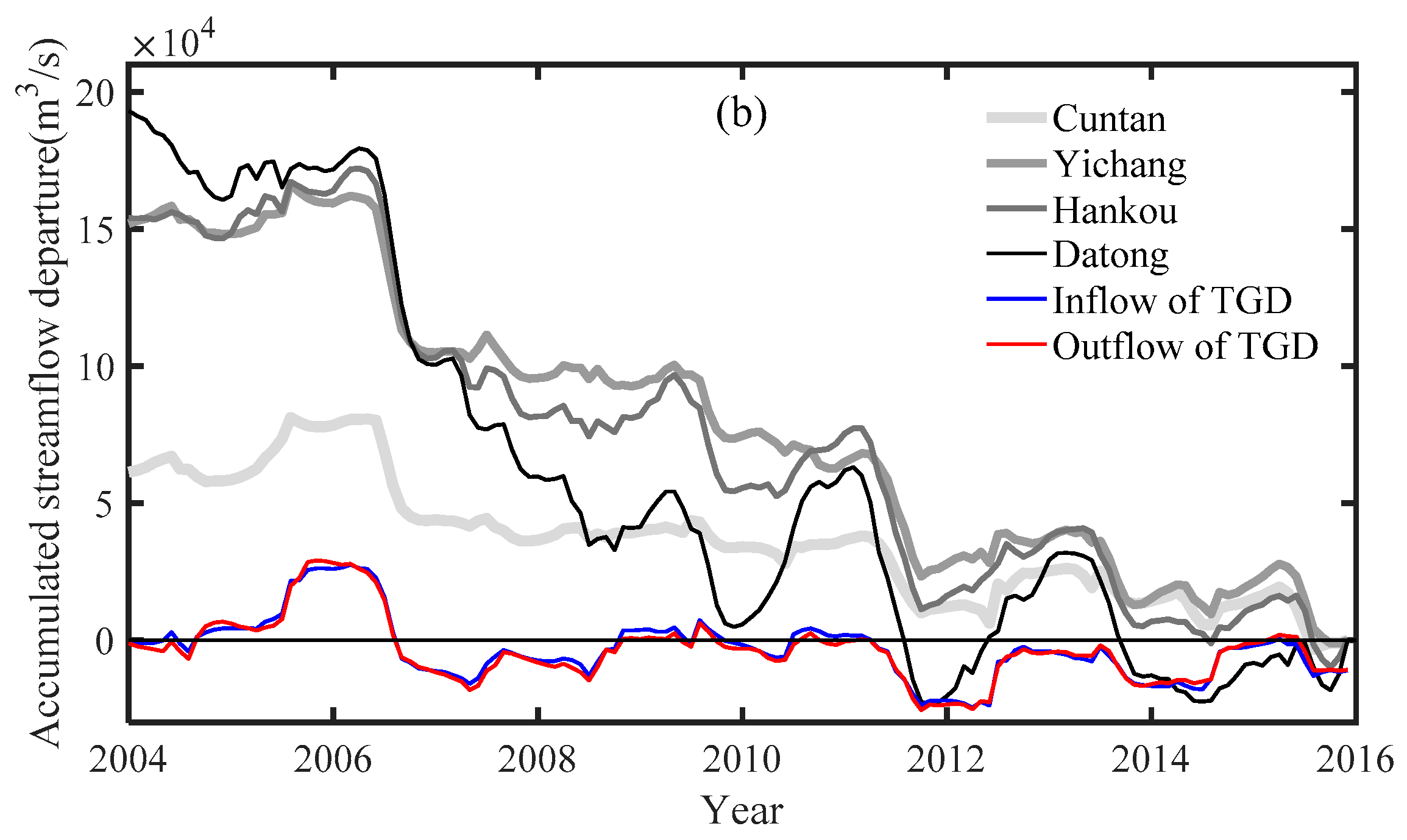
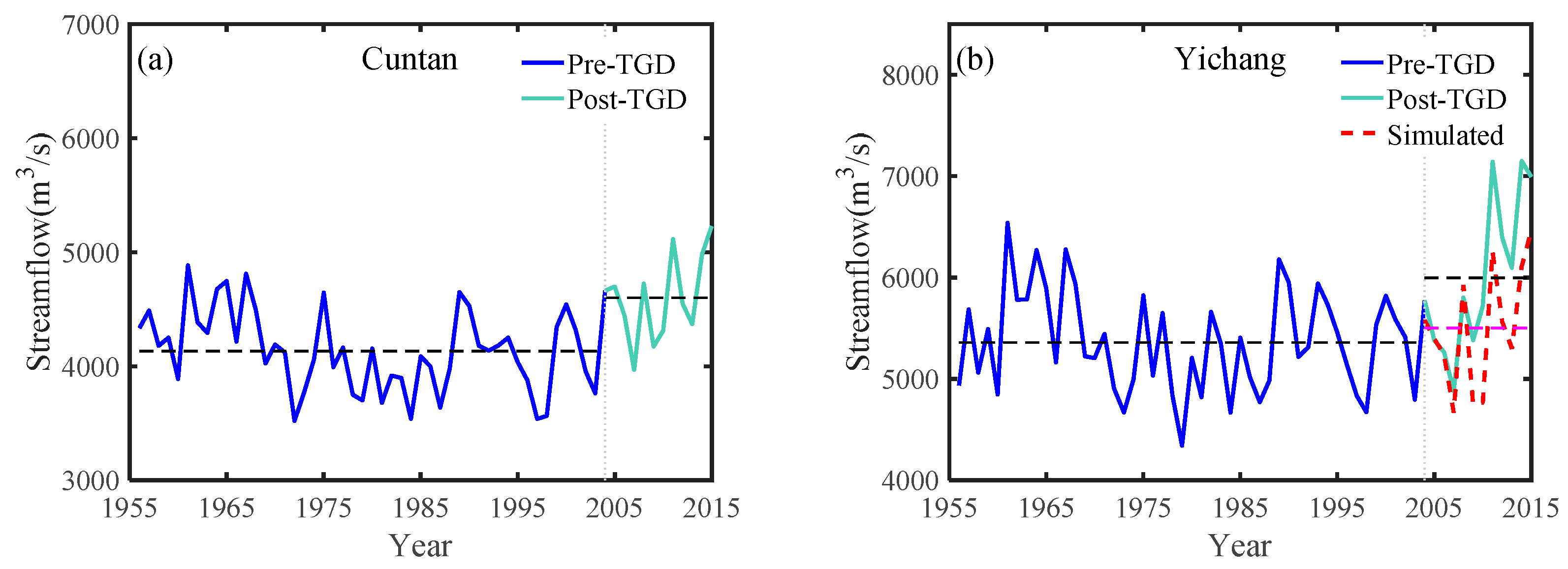
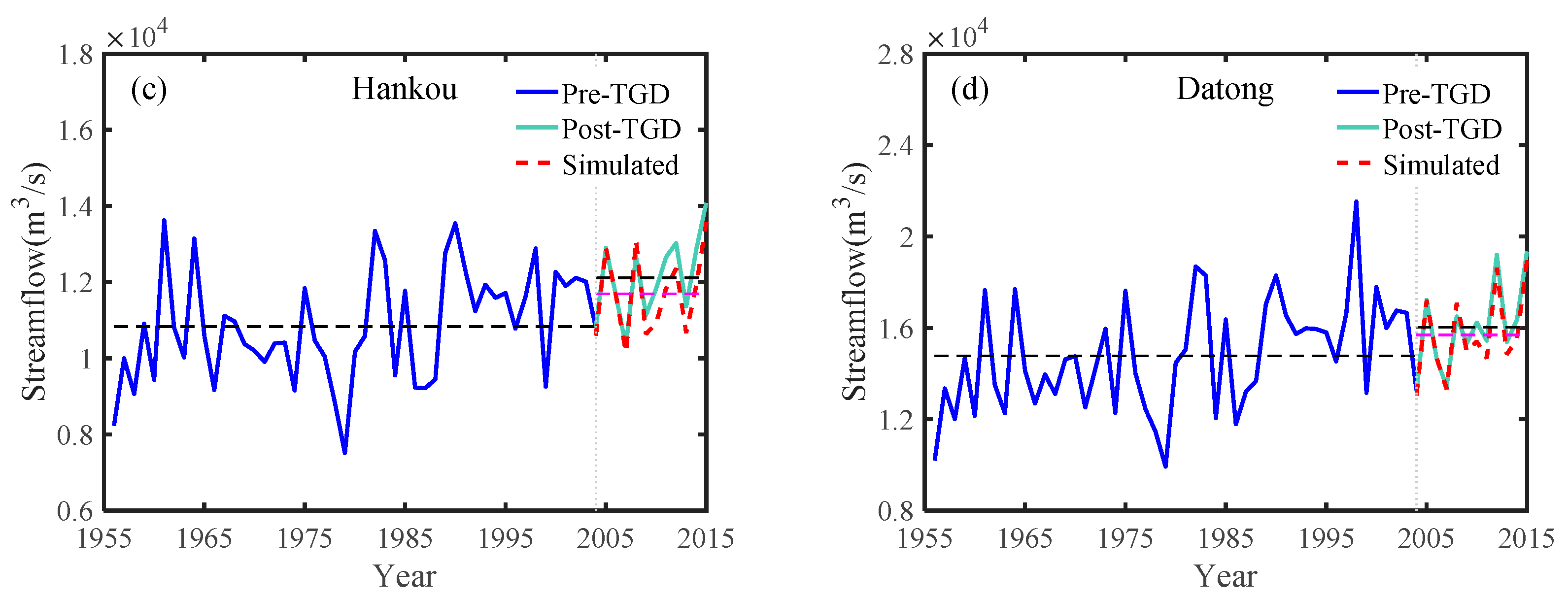
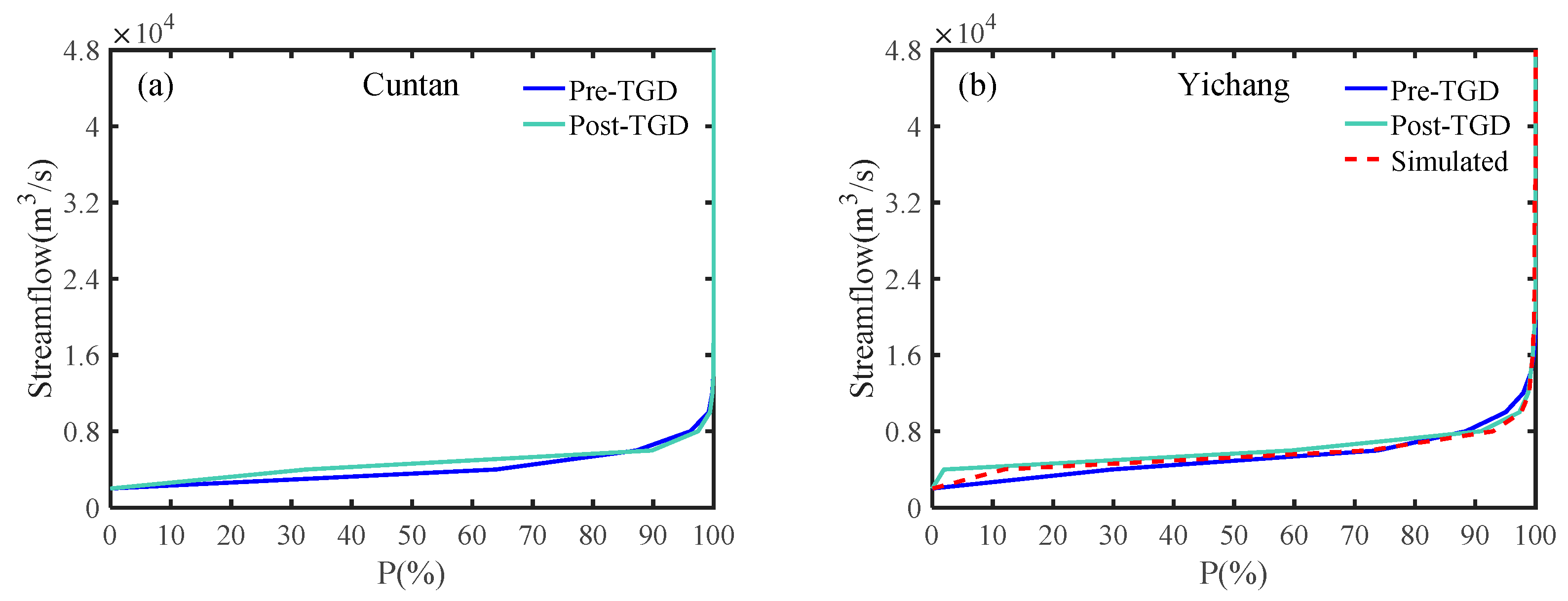
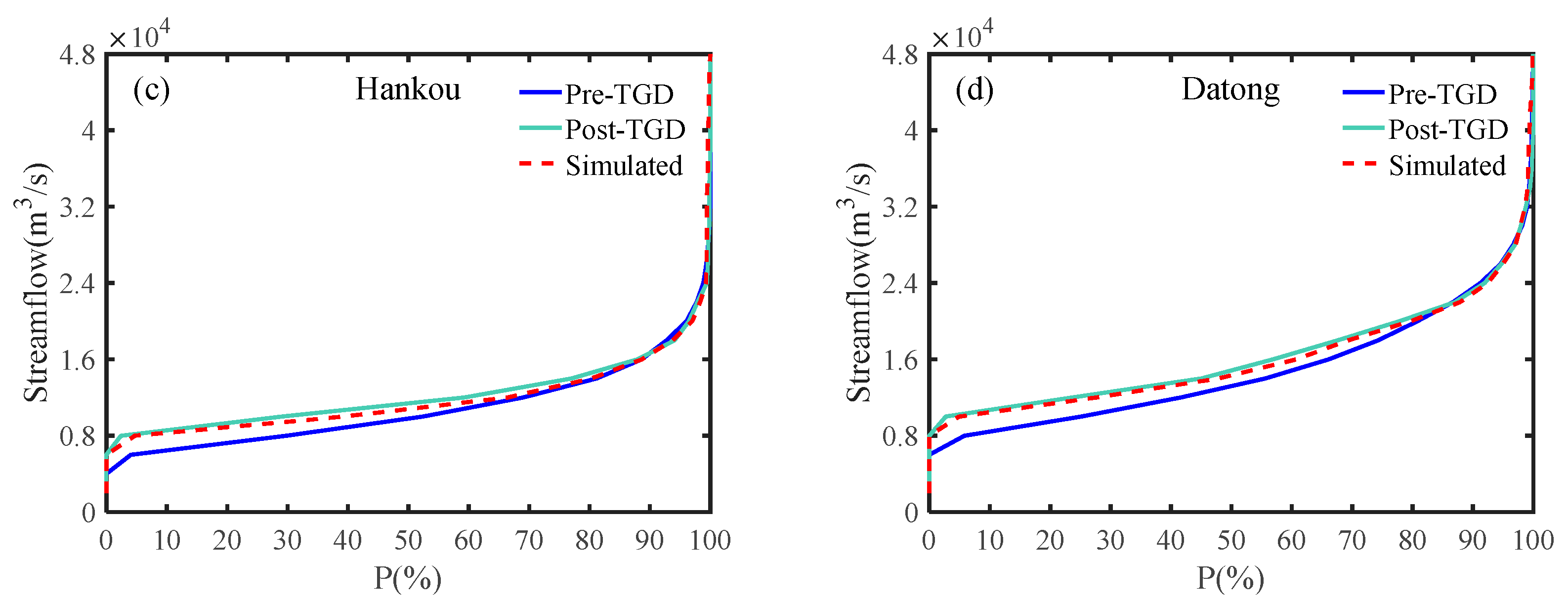
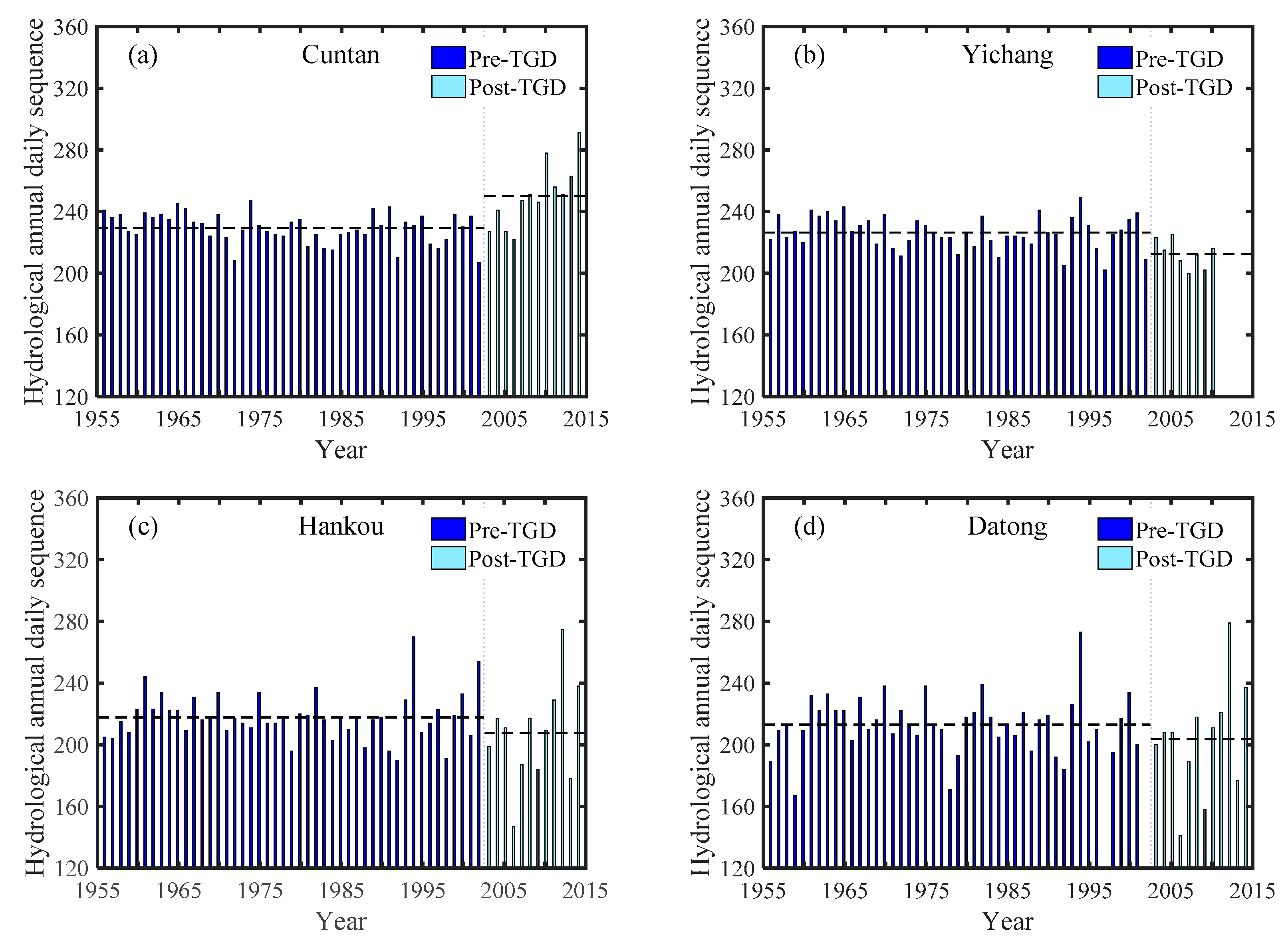
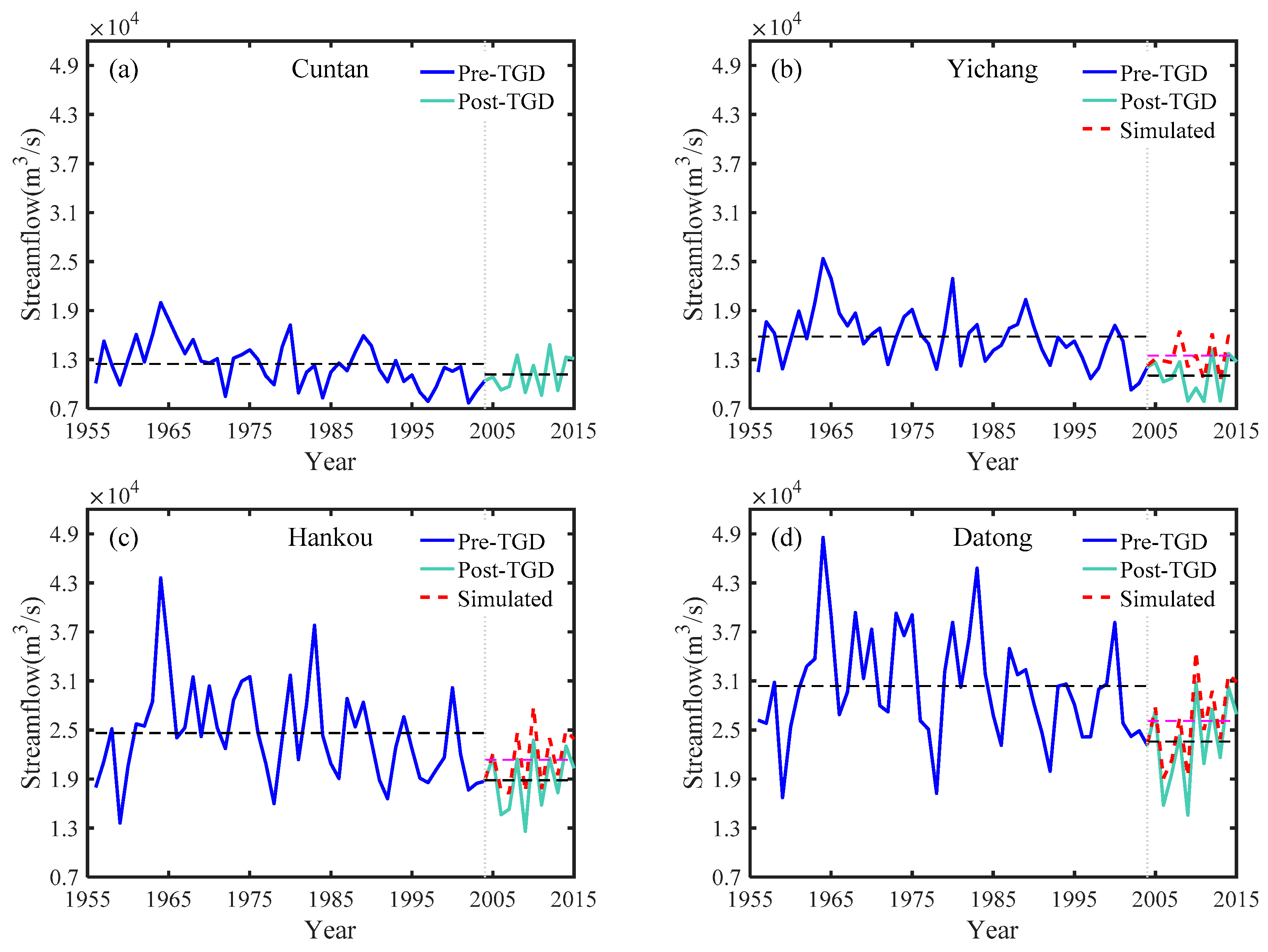
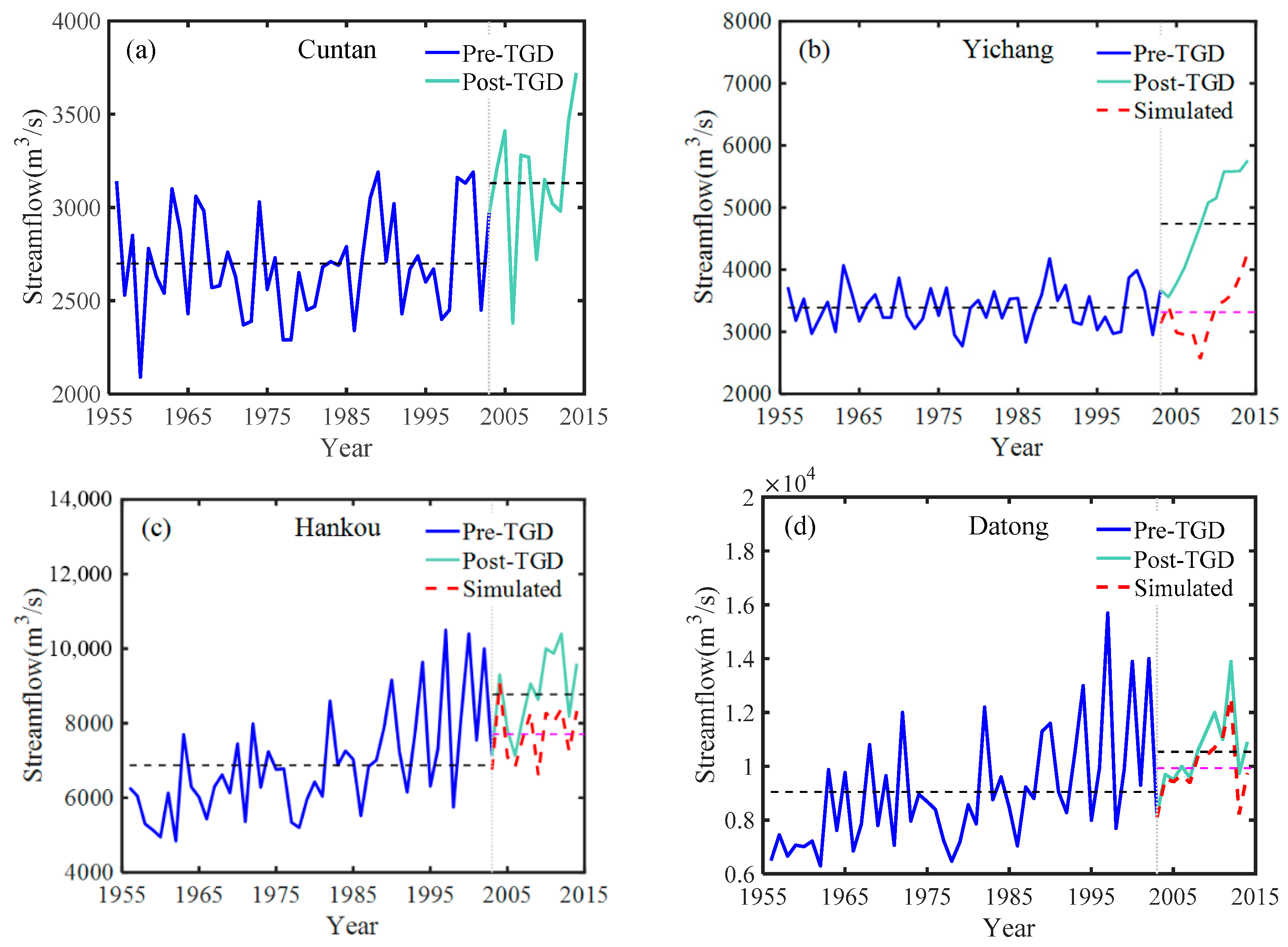
| Stations | Qpre (m3/s) | Qpost (m3/s) | Qsim (m3/s) | ∆Q1 (m3/s) | ∆Q1/Qpre (%) | ∆Q2 (m3/s) | ∆Q2/Qsim (%) |
|---|---|---|---|---|---|---|---|
| Cuntan | 10,886.61 | 10,350.38 | — | −536.23 | −4.93 | — | — |
| Yichang | 13,702.11 | 12,370.62 | 12,448.84 | −1331.49 | −9.72 | −78.21 | −0.63 |
| Hankou | 22,399.69 | 21,037.88 | 21,117.02 | −1361.81 | −6.08 | −79.14 | −0.37 |
| Datong | 28,273.71 | 26,563.96 | 26,643.18 | −1709.75 | −6.05 | −79.21 | −0.3 |
| Stations | Qpre (m3/s) | Qpost (m3/s) | Qsim (m3/s) | ∆Q1 (m3/s) | ∆Q1/Qpre (%) | ∆Q2 (m3/s) | ∆Q2/Qsim (%) |
|---|---|---|---|---|---|---|---|
| Cuntan | 4132.27 | 4602.41 | — | 470.14 | 11.38 | — | — |
| Yichang | 5360.01 | 5998.59 | 5502.77 | 638.58 | 11.91 | 495.83 | 9.01 |
| Hankou | 10,834.78 | 12,110.9 | 11,693.19 | 1276.12 | 11.78 | 417.71 | 3.57 |
| Datong | 14,773.27 | 16,026.79 | 15,696.48 | 1253.52 | 8.49 | 330.31 | 2.1 |
| Stations | Qpre (m3/s) | Qpost (m3/s) | Qsim (m3/s) | ∆Q1 (m3/s) | ∆Q1/Qpre (%) | ∆Q2 (m3/s) | ∆Q2/Qsim (%) |
|---|---|---|---|---|---|---|---|
| Cuntan | 2693.19 | 3130.83 | — | 437.64 | 16.25 | — | — |
| Yichang | 3383.19 | 4738.33 | 3315.61 | 1355.14 | 40.06 | 1422.72 | 42.91 |
| Hankou | 6870.64 | 8771.67 | 7710.36 | 1901.03 | 27.67 | 1061.31 | 13.76 |
| Datong | 9044.47 | 10,533.33 | 9931.93 | 1488.87 | 16.46 | 601.40 | 6.06 |
| Return Period (Years) | Yichang | Hankou | Datong | ||||||
|---|---|---|---|---|---|---|---|---|---|
| Qobs (m3/s) | Qsim (m3/s) | ∆Q/Qsim (%) | Qobs (m3/s) | Qsim (m3/s) | ∆Q/Qsim (%) | Qobs (m3/s) | Qsim (m3/s) | ∆Q/Qsim (%) | |
| 10 | 6316 | 6145 | 2.78 | 13,049 | 12,912 | 1.06 | 18,200 | 18,108 | 0.51 |
| 20 | 6632 | 6284 | 5.55 | 13,546 | 13,419 | 0.95 | 19,105 | 19,032 | 0.38 |
| 50 | 7020 | 6385 | 9.95 | 14,048 | 13,942 | 0.76 | 20,068 | 20,028 | 0.2 |
| 100 | 7298 | 6426 | 13.56 | 14,341 | 14,254 | 0.62 | 20,662 | 20,651 | 0.05 |
© 2019 by the authors. Licensee MDPI, Basel, Switzerland. This article is an open access article distributed under the terms and conditions of the Creative Commons Attribution (CC BY) license (http://creativecommons.org/licenses/by/4.0/).
Share and Cite
Tian, J.; Chang, J.; Zhang, Z.; Wang, Y.; Wu, Y.; Jiang, T. Influence of Three Gorges Dam on Downstream Low Flow. Water 2019, 11, 65. https://doi.org/10.3390/w11010065
Tian J, Chang J, Zhang Z, Wang Y, Wu Y, Jiang T. Influence of Three Gorges Dam on Downstream Low Flow. Water. 2019; 11(1):65. https://doi.org/10.3390/w11010065
Chicago/Turabian StyleTian, Jiaxi, Juan Chang, Zengxin Zhang, Yanjun Wang, Yifan Wu, and Tong Jiang. 2019. "Influence of Three Gorges Dam on Downstream Low Flow" Water 11, no. 1: 65. https://doi.org/10.3390/w11010065
APA StyleTian, J., Chang, J., Zhang, Z., Wang, Y., Wu, Y., & Jiang, T. (2019). Influence of Three Gorges Dam on Downstream Low Flow. Water, 11(1), 65. https://doi.org/10.3390/w11010065






